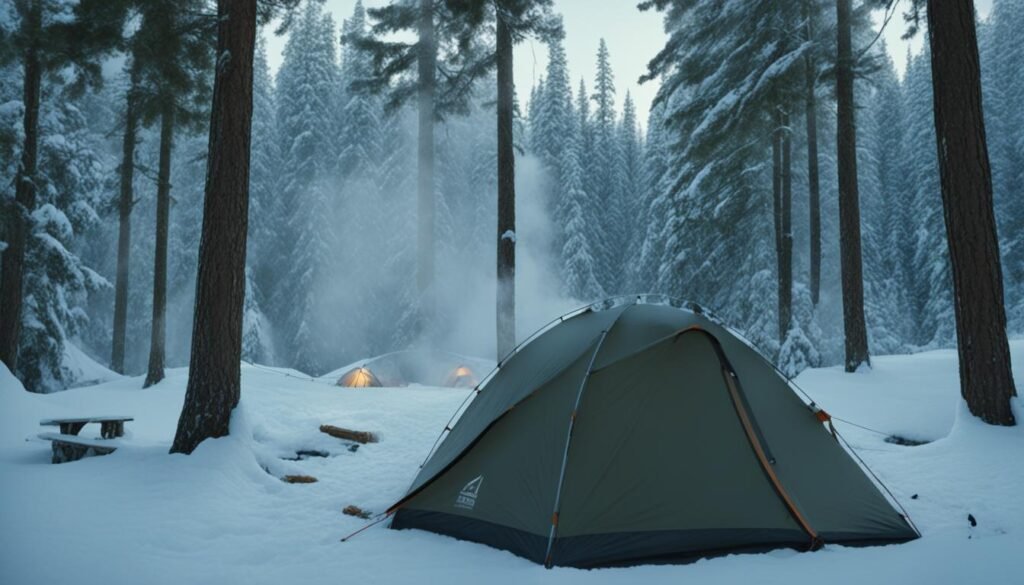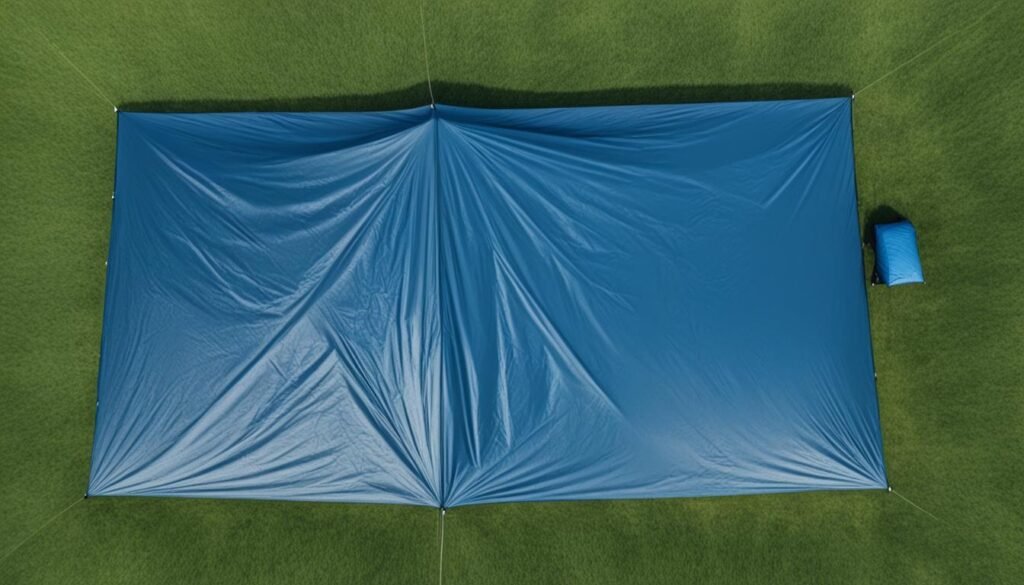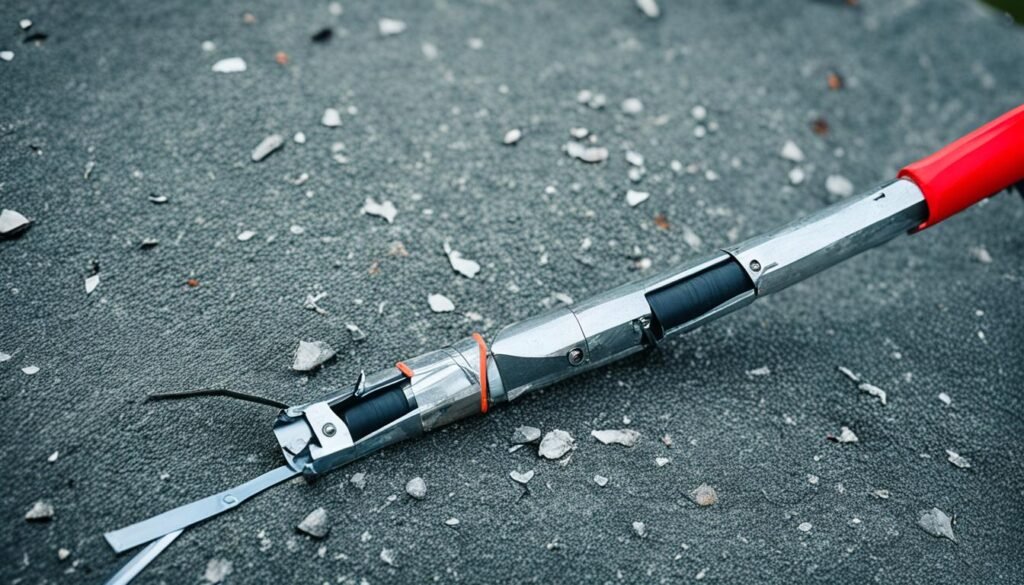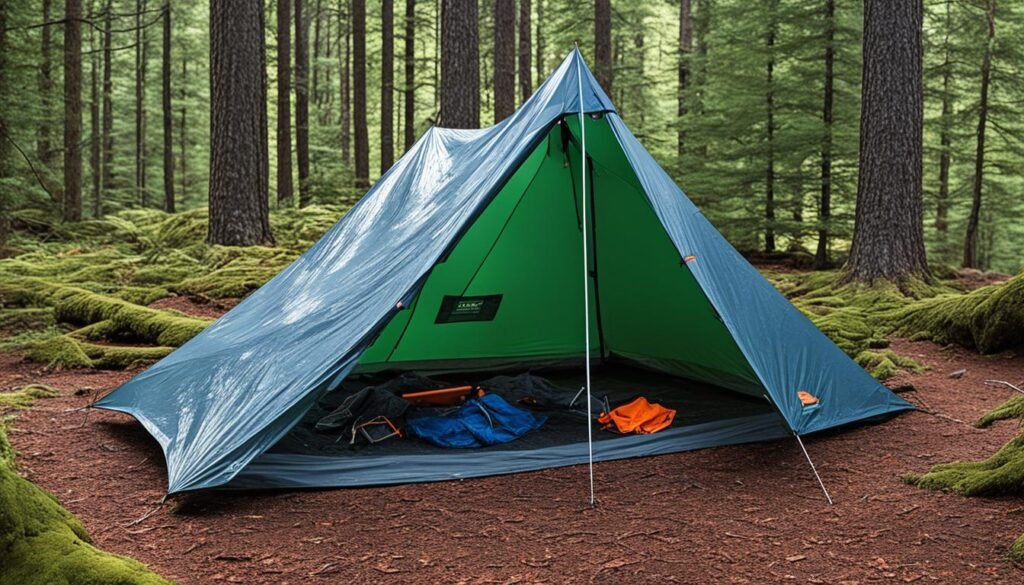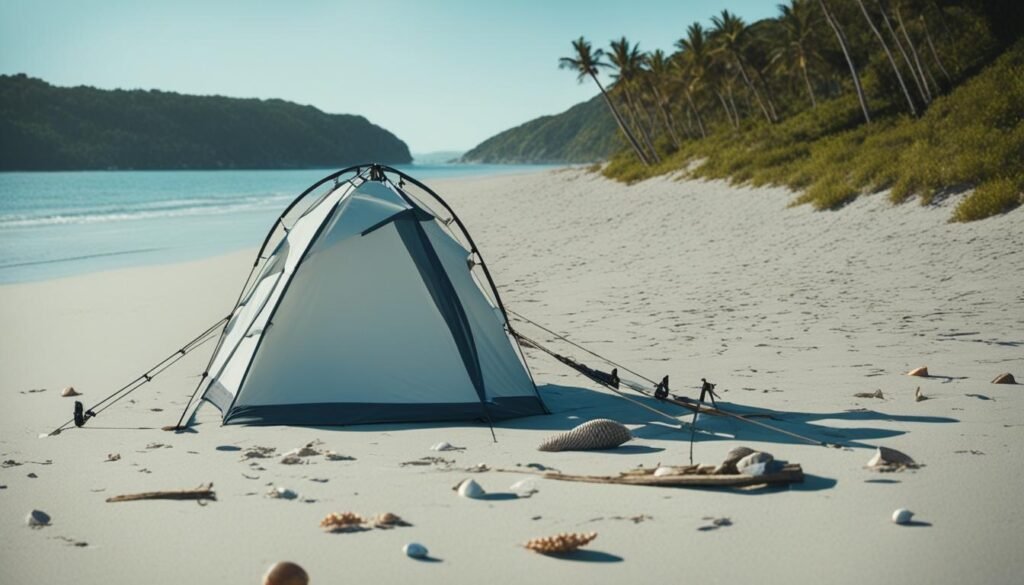As an avid camper, I’ve come to realize that the joys of camping need not fade as the temperature drops. Venturing into cold weather camping brings its unique thrills, provided you’re equipped with the right knowledge on how to insulate a tent. Heat retention in tents becomes a critical skill, turning a winter campsite from a chilling ordeal into a cozy refuge. Over the years, I’ve gathered an arsenal of winter camping tips, mastering techniques that stem from choosing compact sleeping quarters such as the UNA hammock tent for solitary excursions or the Flite for a duo’s snug shelter.
Understanding the intricacies of trapping warmth means adopting a mindset geared towards thermal efficiency. A key to this is recognizing that when it comes to keeping warm in a tent, a smaller footprint means you’re heating less volume, thus your body heat remains your loyal companion through the long winter nights.
Let me share with you strategies that encompass not only the setup but also the gear, such as integrating a SkyPad sleeping mat with an R-value that speaks volumes about its thermal resistance. And let’s not overlook the comfort provided by the newly expanded Inner Quilt range. Together, these are the bulwarks that shield against the cold seeping in from below and the sides. So, pull your mummy sleeping bag a little closer and let’s delve into the art of insulating your tent for a serene adventure amidst the winter’s embrace.
Key Takeaways
- Choosing a smaller tent like the UNA or Flite can significantly improve heat retention in tents.
- R-value is crucial – SkyPad’s 4.4 R-value and Inner Quilt’s 2.7 R-value are foundational for warmth.
- Effective floor and wind insulation are essential elements in how to insulate a tent.
- Covering techniques, including premium rainflies and foil thermal blankets, are pivotal for cold weather camping.
- Winter camping tips include the use of ethically sourced mummy sleeping bags and safely employing heat packs or hot water bottles.
Understanding the Basics of Tent Insulation
My winter camping experiences have taught me the value of understanding fundamental tent insulation methods. The core concept is simple: maintain warmth by minimizing heat loss, a challenge I relish with each frosty breath in the backcountry. Drawing from my expertise, I’ve learned that convection is the foe of any camper seeking solace from the cold. By mastering the art of insulation, the tent becomes a bastion against the frigid climes, a harbor where warmth is curated and cold is a mere outsider looking in.
To achieve this, one must utilize the best insulation materials for tents, materials specifically designed to counter the harsh whispers of winter winds. The interplay of body heat and icy air forms a duality of discomfort, leading to the dreaded condensation that can turn a tent into a canvas of cold. By employing proper insulation techniques, not only do I keep warm in a tent, but I also fortify my sanctuary against the silent threats of hypothermia and respiratory distress.
Convection, the process that threatens the warmth of my camping nights by whisking away heat, becomes less menacing with layers of thoughtfully chosen materials. Assembling a barrier to trap warmth and defy cold seepage is a meticulous process, but one well worth the effort. Let me elucidate the essentials for turning your tent into an impervious cocoon of warmth.
- The first step is selecting materials with a high resistance to thermal transfer—insulation with a higher R-value.
- Secondly, assessing the environment and considering best practices for site selection fortifies my position against the elements.
- Lastly, reinforcing my warm haven with additional layers of insulation on all fronts—ground, walls, and roof—ensures that the warmth generated within stays within.
It’s a tactical battle against cold, one that well-prepared campers can certainly win. The methodology is straightforward: a material’s R-value signifies its insulating prowess, guiding my choices as I build up my defenses. Whether I’m lining the floor with thermal blankets or draping a protective layer overhead, each step is a calculated move to contain heat where it belongs—around me. A wise selection of insulation materials marks the difference between a night spent in shivers and one spent in serene warmth.
Join me as I dive deeper into the strategies that form the core of tent insulation, a knowledge base that shall transform your winter camping from an ice-laden quest into a quest that’s sublimely insulated against the whims of winter.
| Insulation Area | Method | Materials | Expected Benefit |
|---|---|---|---|
| Floor | Layering | Closed-Cell Foam, Thermal Blankets | Minimize heat loss from ground |
| Walls | Internal Lining | Insulating Fabrics, Space Blankets | Reduce cold drafts and condensation |
| Rooftop | Reflective Covering | Foil Thermal Blankets | Retain body heat within tent |
| Outer Shell | Windbreaks | Tarps, Natural Barriers | Shield against wind chill factor |
As a seasoned camper, my mantra has been to never compromise on comfort, for the plummeting temperatures should not dictate the warmth within my nylon castle. With proper tent insulation methods, you can be assured that the winter’s chill shall remain a spectator to the comfort of your expedition, never the intruder. Let this knowledge of insulating your tent for cold weather be your guide, your shield against the cold’s domain, and your companion in the pursuit of serene winter nights under the stars.
Selecting the Right Tent for Chilly Climates
When the mercury drops, the right kind of shelter can make or break your winter camping adventure. Embarking on a quest to find the perfect four-season camping tent is a critical first step in prepping for the cold. Brands such as Mountain Hardwear, NEMO, The North Face, and Hilleberg stand out with offerings that are tried and tested in the harshest of winter conditions. These insulated winter tents are engineered to withstand high winds, repel heavy snow, and lock out the icy embrace of cold air.
Yet, the key to selecting a winter tent goes beyond just its resilience against the elements. It’s also about optimization for heat retention. My experience whispers that the decision should lean towards a smaller tent. Why? Because a compact space is quicker to warm and much easier to maintain that desired coziness. The volume of air space is everything—the less there is, the less heat you will need to generate to keep the tent’s interior a comfortable haven.
Let’s unpack some of the tent insulation methods employed by these seasonal shelters. For instance, four-season tents often include features such as reduced mesh panels, robust pole structures, and denser fabric weaves. Even the way their rain flies hug the frame—closer, allowing for minimal airflow—distinguishes them from their three-season counterparts.
- Tight rain fly design to minimize heat loss
- Strong poles and durable materials to combat harsh winds
- Fewer mesh panels to reduce exposure to biting drafts
Delving into specifics, I’ve found the technology behind these winter refuges fascinating. Take Mountain Hardwear’s Trango or The North Face’s Mountain 25—these tents come with floors that resist moisture and sidewalls that buffer gusts, creating microclimates within that are both dry and warm.
In addition to the advanced tent insulation methods these brands offer, it’s insightful to consider the tent’s color—a dark tent absorbs more sunlight during the day, giving you a bit of a thermal head start as the sun dips. Also, dual vestibules are useful, not only for storing gear but for insulating the living area.
Above all, I stress that the decision should align with rational expectations of use, balancing the functionality with the environment. For a trustworthy habitat that shields against winter’s tenacity, your tent should be more than a shelter—it should be a partner against the perils of the cold, a true embodiment of the outdoor spirit that never falters, even when faced with the chilliest of climates.
How to Insulate a Tent
Those who’ve braved the chill of the wild know that how to insulate a tent can be the deciding factor between a refreshing morning and a shiveringly long night. It’s a harmonious blend of technique and material, of how all elements work together to create a thermal haven. My camping ventures into the frosty air have led me to appreciate the science of staying warm – it begins with the tent itself. Let’s walk through the process and consider the strategies that can transform your shelter into a snug winter hideaway.
While keeping warm in a tent may seem as simple as bundling up, the reality is far more strategic. Insulation efforts must cover all bases—starting from the ground all the way to the lofty reaches of your temporary abode’s canopy. Each strategy implemented is a stitch in the quilt that will cloak you in warmth through the moonlit hours.
The Importance of a Smaller Footprint
In the quest for warmth, the economy of space plays a leading role. A smaller tent footprint does not demand as much body heat to warm up, making DIY tent insulation efforts more effective. Picture a quaint, compact space – it’s easier to fill with heat and far more manageable when it comes to retaining it. This principle is not just a convenience; it’s a necessity when the cold is unforgiving.
Floor Insulation Strategies
The cold ground beneath can seem an insatiable thief, stealing away heat with reckless abandon. Counter this by laying down a multiplicity of barriers. A tent footprint is essential, followed by layers of foam sleeping pads. This sandwich of materials not only insulates but also adds a level of desired comfort—essential after a day of adventure.
| Insulation Layer | Material | Function | Benefit |
|---|---|---|---|
| Base | Tent Footprint | Shields from moisture | Keeps bottom layer dry |
| Mid-Layer | Foam Sleeping Pads | Provides thermal barrier | Blocks cold, adds comfort |
Implementing Wind Breaks
Wind can slice through warmth like a knife through silk. Erecting windbreaks by capitalizing on natural landscapes helps. If the terrain doesn’t yield such advantages, creating artificial barriers may become necessary. Sometimes, something as simple as positioning your tent strategically with respect to the prevailing winds can make all the difference in tent insulation methods.
Maximizing Heat Retention with Tent Covers
The final dome that shields from the chill is the tent cover. A quality rainfly is non-negotiable, but think beyond this. A thermal blanket strategically draped atop can reflect heat back, creating a self-sustaining microclimate of warmth. This fusion of layers serves as the capstone in my tent insulation methods, ensuring the winter whispers remain outside, where they belong.
The intertwining of these practices forges not just a shield against the cold, but a bastion of warmth—turning mere survival into comfort. A well-insulated tent is the canvas on which remarkable winter memories are painted, and with these guidelines at your fingertips, you’re well on your way to mastering the craft of DIY tent insulation. Stay warm, stay inspired, and let the cold be just another chapter in your adventure saga.
Essentials of Floor Insulation for Heat Retention
Embarking on a winter adventure in the great outdoors, I’ve learned that ground insulation is not just an add-on but a necessity for retaining vital warmth. The icy ground beneath us is relentless, conducting away precious heat that can mean the difference between comfort and a shiver-ridden night. That’s why one of my first steps after selecting the right tent location is to lay down a footprint right beneath my shelter. This seemingly simple addition acts as a critical barrier, an initial layer in our floor insulation strategies to shield against the cold, damp earth.
But I don’t stop there. The next phase involves layers of insulating foam pads, each boasting an R-value designed to combat the cold with scientific precision. It’s these layers that create a separation that’s not just physical, but thermal—a barrier that my core heat will not surrender to the greedy clutches of the frozen ground. In my pursuit of DIY tent insulation, I’ve also discovered the comfort that a well-placed blanket or rug can provide. Placed either over or beneath the foam pads, these additional layers work double-duty, offering extra comfort underfoot while enhancing the overall insulation of my winter abode.
Let’s take a closer look at the strategic layers that have served not only me but many fellow cold-weather campers:
| Layer | Material | Function | R-Value | Added Benefit |
|---|---|---|---|---|
| Ground barrier | Tent Footprint | Protects from moisture | Varies | Dryness |
| Primary insulation | Foam Pads | Creates thermal buffer | High | Heat retention |
| Secondary layer | Blankets/Rugs | Adds comfort and warmth | N/A | Enhanced padding |
As I lay out my tent, these layers come together in a symphony of insulation, each bringing its own tone of warmth to the ensemble. Together they form not just a floor but a foundation against the biting cold—a firm reassurance that within these canvas walls, the icy fingers of winter shall not find me.

In all my camping exploits, this approach to insulating the tent floor has proven time and again to be invaluable. It’s the groundwork for a snug retreat—a sanctuary where the cold becomes an afterthought and tranquility reigns. Sharing these methods with you, I hope to empower your winter camping experiences with warmth, transforming the act of insulating your tent from a chore into an effective, satisfying ritual.
DIY Tent Insulation Techniques
Winter camping adventures can be filled with serene snowfall and the tranquility of a landscape at rest. Yet, the plummeting temperatures present a real challenge, specifically in how to insulate a tent effectively. With ingenuity and a bit of DIY spirit, my winter camping tips tailored toward creating a warm refuge are both accessible and efficient. Even when on a budget, insulation doesn’t have to be expensive or complicated. It’s about utilizing what you have effectively and sometimes, what nature provides.
As a camper who thrives on personalizing my outdoor experience, I’ve developed several homemade solutions that enhance thermal comfort within my tent. Utilizing everyday materials, salvaging natural resources, and understanding the physics of heat retention has enabled me to extend my camping season deep into the colder months. Here’s how I’ve tackled the task:
Homemade Thermal Barriers
My initial approach to DIY tent insulation is creating homemade thermal barriers. These are easy to fabricate and profoundly beneficial. Employing old blankets or purchasing affordable insulating fabrics, I fashion barriers that snugly fit within my tent’s interior. By layering these materials against the walls of the tent, I’m able to significantly hinder heat from escaping; it is a practical solution that offers a comforting shield against the cold night air.
Using Natural Materials
Insulation doesn’t only come from man-made materials, though. I often look to my immediate environment for tent insulation methods provided by nature itself. A bed of dry leaves or hay under the tent acts as a perfect environmentally friendly layer of insulation that provides a minor elevation from the direct cold of the ground. This natural buffer not only enhances warmth but also maintains a sense of harmony with the surrounding environment.
Adapting Reflective Surfaces
Reflective surfaces such as space blankets are another ace in my DIY repertoire. These are not just for emergencies. By lining the interior roof and walls of my tent with these reflective materials, I maximize the effect of reflected body heat, essentially using my own energy as a heating source. The metallic surface bounces warmth back into the tent, keeping me snug while I revel in the pristine beauty of winter’s handiwork outside.
Through these DIY tent insulation efforts, my winter camping experiences have transformed. Each time I set up camp, I adapt these techniques to the specific demands of the environment and the weather, ensuring that the warmth I create within my tent remains constant, regardless of the chill outdoors. By sharing and implementing these winter camping tips, I hope to inspire other campers to extend their seasons and enjoy the unique beauty of the colder months in comfort.
Optimizing Wind Breaks around Your Campsite
As I venture into the wilderness, my focus sharpens on the meticulous art of tent insulation methods. It’s not merely about nesting in a safe haven but sculpting an environment that repels the chill. In my arsenal of strategies, implementing wind breaks is a tactical maneuver, essential to keeping warm in a tent. This technique, a dance between human ingenuity and the raw elements of nature, requires an understanding of the landscape and a smart use of materials to craft an effective line of defense against the invading cold winds.
Positioning the tent with precision, I align it with natural formations that stand as silent sentinels against the wind. These giants of stone and shrub weave their own magic, staving off gusts that would otherwise penetrate the sanctuary of my tent. But where nature falls silent, my hands craft the barriers needed. Tarps, stretched and secured, like the walls of a fortress, create an artificial shield that cozies up to my nylon abode, keeping the inside warm and wind-free.
| Type of Wind Break | Advantages | Considerations |
|---|---|---|
| Natural Landscapes | Eco-friendly, inherently stable | Dependent on campsite location |
| Man-made Structures | Customizable, strategically placed | Requires materials and setup time |
| Tarps and Tent Walls | Effective barriers, additional storage space | Must be secured against wind force |
It’s both science and art, optimizing these wind breaks. I observe the direction of the wind, the lay of the land, feeling the currents that flow unseen yet deeply felt. In my experience, the orientation of the windbreak can make a significant impact. Thus I align my defenses where they will absorb the onslaught, preserving the bubble of warmth my preparations have created. With the windbreaks in place, a serene evening awaits, where the whispers of the cold remain outside my canvas boundaries.
The satisfaction of a well-constructed wind barrier is not solely in its immediate warmth. It’s the peace of mind that comes with knowing I’ve sealed away the cold, and in this battle against nature’s elements, I emerge ensconced in warmth, ready to face the night ahead. Through careful planning and the strategic use of these windbreaks, my endeavors ensure that even amidst the wild chill, comfort in my campsite remains undiminished.
Ways to Use Tarps and Covers for Insulation
On my many forays into the wild under the shroud of winter, my experiences have taught me invaluable tent insulation methods. Beyond the tent’s fundamental fabric, additional measures like the strategic application of tarps and covers are imperative. Learning how to insulate a tent effectively involves not just understanding these materials’ insulating properties but also their apt deployment for maximizing heat retention with tent covers.
I have found, through trial and reflection, that the addition of a tarp ingeniously draped over the tent creates a sturdy layer against the bitter cold and invading moisture. The technique is simple yet profound: the tarp adds an extra barrier, and when positioned correctly, it channels away precipitation and prevents the unfortunate pooling of cold water that can sap warmth from your encampment.
Further fortifying your stronghold against the cold, a bespoke cover akin to a thermal blanket can act as a dual-function marvel. Laid atop your tent, such a cover serves not only as a waterproof membrane but also as a reflective surface, mirroring your body heat back within the tent. This method has proven fundamental in my winter camping endeavors, adding a conspicuous increase to my tent’s insulating capacity.
Let me share a layout of how best to utilize these auxiliaries:
- Choosing the Right Tarp: Opt for a durable and waterproof tarp that is suitably large enough to cover the entire tent.
- Proper Placement: Erect the tarp with a slight incline, ensuring moisture runs off away from the tent rather than pooling.
- Securing for Stability: Anchor the tarp firmly to the ground or around trees to withstand wind and accumulate snow.
- Utilizing Thermal Blankets: Position a specialized thermal blanket between the tent’s rainfly and the tarp to reflect warmth back into the tent.
There’s a certain satisfaction in employing these methods, not just for their functional benefits but also for the element of personal touch they bring to your winter shelter. They transform a tent from a mere structure into a bastion of warmth, ensuring the winter’s chill is kept at bay.
In conclusion, my practice of leveraging tarps and thermal covers has been instrumental in the endeavor to create a warm camping experience. As you venture into the brisk outdoors, may these insights into maximizing heat retention with tent covers enrich your journey as they have mine.
Selecting Proper Sleeping Gear for Warmth
As someone who embraces the brisk tranquility of winter camping, I have come to understand that a night under the stars is only as good as the sleeping gear you tuck into. In the realm of selecting proper sleeping gear, the sleeping bag reigns supreme. It’s not just about choosing the right sleeping bag; it’s about curating an arsenal that ensures the icy grip of night does not tarnish your camping experience.
The myriad of options available could leave one tangled in a web of polyfill and feathers, but the compass that navigates one through this selection is a sleeping bag’s temperature rating. Selecting a sleeping bag that can withstand temperatures beyond the lowest expected conditions is not an overreach; it’s a shield against the unexpected. When the wind howls with winter’s chill outside, a sleeping bag with an accurate temperature rating is a silent guardian against the cold.
Yet, warmth doesn’t simply end at the efficiencies of modern synthetic fillings or the plush loft of down. Additional layers, such as a sleeping bag liner, can weave extra warmth into the fabric of your nighttime retreat, cradling you with an added layer of insulation—crucial for those who seek the solace of sleep in nature’s coldest quarters.
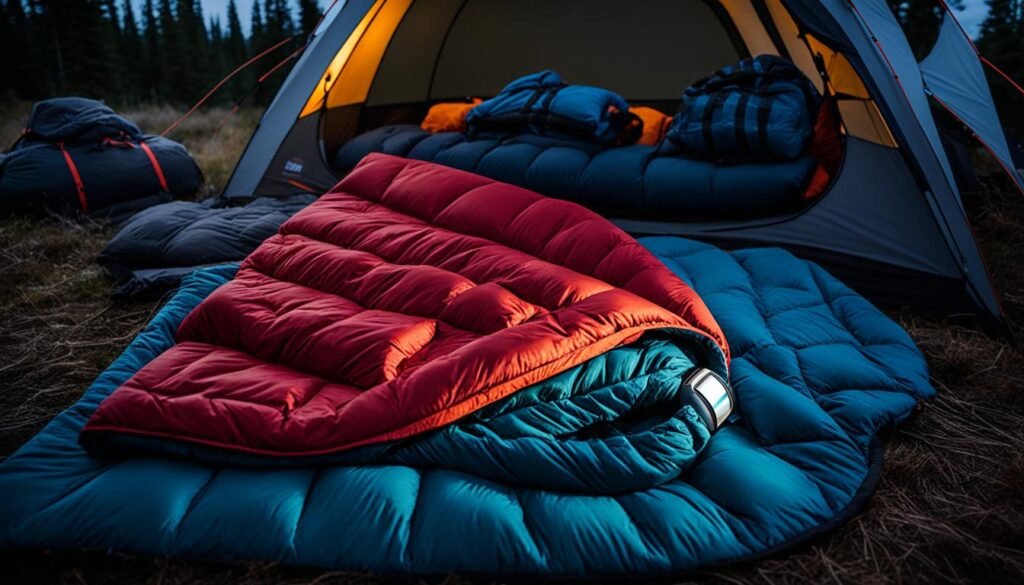
Mummy-style sleeping bags, with their cocoon-like design, have served me well—forming a capsule of warmth. The drawstring hood snugs around the head, leaving the face exposed to the world of stars and silence, while retaining the body heat so vital in the solitude of a winter’s night. The design narrows at the legs and feet, creating an intimate environment for heat retention, ensuring that every shred of warmth generated is conserved meticulously, a personal haven within the enveloping darkness.
- Temperature Rating: Essential for selecting a bag appropriate for the conditions.
- Mummy Shape: Optimizes heat retention with a close-fitting design.
- Sleeping Bag Liner: Adds an additional layer of insulation.
Armed with the right gear, retreating into the embrace of a frigid evening is no longer daunting. It’s a composed entry into a realm resistant to the plummeting temperatures—a testament to the prowess of winter camping tips put into practice. With warmth secured, the night’s peace isn’t marred by an unending fight against the cold, but rather colored by serene slumber, and the reassurance that the gear you’ve chosen stands as a bulwark against the elements.
Choosing the Best Insulation Materials for Tents
As someone who’s pitched tents under the stars on the chilliest of nights, I know firsthand that the right insulation materials for tents make all the difference between a restful sleep and a fitful night. Delving into the heart of tent insulation requires not only robust materials but also an understanding of thermal dynamics.
Understanding R-values in Insulation
At the core of any insulative material is its R-value; a pivotal factor in determining how well a substance can resist heat flow. The higher an R-value, the more capable the material is at providing thermal resistance, making it a crucial consideration for best insulation materials for tents. Whether it’s the high R-values of closed-cell foam pads or the specialized sleeping mats that cater to the rugged outdoors, I’ve come to appreciate materials that stand up to the biting cold with indisputable efficacy.
Comparing Synthetic vs. Natural Insulators
When I compare insulation types, synthetics consistently deliver the reliable and enduring properties that extreme conditions demand. Synthetic insulators – think high-tech polyester fibers or reflective foil barriers – are my go-tos for their ability to shrug off moisture and maintain heat retention. However, natural insulators have their place too. Their sustainability and cost-efficiency are undeniable, although I’d be remiss not to mention that their performance may fluctuate in damp environments – not ideal when you’re learning how to insulate a tent effectively.
With DIY tent insulation, creativity becomes your ally, but pair it with practical choices for the ultimate warmth in wild spaces. Below is a table summarizing the top contenders in insulation materials, gauging them by their R-values, advantages, and best use-scenarios:
| Insulation Type | R-Value (Approx.) | Benefits | Best For |
|---|---|---|---|
| Closed-Cell Foam Pads | 2-5 | Moisture Resistant, Durable | Floor Insulation |
| Synthetic Fiber Mats | Varies | Lightweight, Compact | Backpacking in Cold Climates |
| Natural Wool Blankets | 1-2 | Sustainable, Comfortable | Mild Weather Camping |
| Reflective Foil Barriers | N/A | Heat Reflection, Versatility | Roof and Wall Lining |
Be it tackling the intricacies of DIY tent insulation or choosing pre-fabricated solutions, my goal is always to err on the side of preparedness. With the best insulation materials for tents securely in place, the rugged charm of cold-weather camping can be embraced wholeheartedly – without ever having to fear the chill.
The Role of Weatherproofing in Tent Insulation
In my many ventures into the frosty wilderness, I’ve found the decisive role that weatherproofing in tent insulation plays cannot be overstated. It’s not merely about withstanding a downpour; weatherproofing serves as a guardian of heat retention in tents. A technique as simple as treating the rainfly with a high-quality product like NikWax fortifies my tent against the ingress of moisture—a common thief of warmth that plagues campers in cold weather.
It’s an essential truth I’ve come to know: keeping dry is synonymous with staying warm. When it comes to insulating a tent for cold weather, a robustly weatherproofed tent is a bulwark against cold air and biting winds. Dry interior air is warmer air, and through the application of waterproofing measures, I create an environment more conducive to trapping valuable warmth over long, frosty nights.

Let’s examine a table of various weatherproofing approaches, highlighting their impacts on insulating capabilities:
| Weatherproofing Method | Product Example | Application | Insulating Benefit |
|---|---|---|---|
| Seam Sealing | NikWax Tent & Gear Solarproof | Applied to seams to prevent leaks | Eliminates moisture penetration points |
| Fabric Coating | Kiwi Camp Dry Heavy Duty Water Repellent | Sprayed onto fabric surfaces | Enhances fabric’s water resistance, reduces dampness |
| Rainfly Treatment | TX Direct Wash-In Waterproofing | Wash-in or spray-on application | Boosts rainfly’s ability to shed water and retain heat |
Employing these weatherproofing methods not only catapults the efficiency of my tent insulation but also contributes deeply to keeping warm in a tent. Moreover, the longevity and structural integrity of the tent are preserved, ensuring that it stands resilient against the relentless conditions encountered while camping in colder environments.
In my personal cache of cold-weather camping essentials, weatherproofing supplies claim prime real estate. The logic is in the longevity; a well-maintained tent, resistant to water and sealed against the drafts, transcends being a mere seasonal shelter—it becomes a reliable companion on many a starlit journey into the chill of nature’s quieter months.
Supplemental Heat Sources for Extreme Cold
When the frigid arms of nature clasp tightly around the canvas of my tent, I often turn to supplemental heat sources to secure a bastion of warmth in the face of extreme cold. These sources, ranging from tent heaters to innovative heat packs, become crucial comrades in my relentless battle against the frost. Learning how to insulate a tent for extreme cold is pivotal, and the considered use of such sources can be a game-changer.
The addition of a tent heater can transform a bone-chilling interior into an oasis of warmth. When selecting a heater, I tread the path of caution, opting for models that are not only portable and efficient but also designed with safety in mind. Propane heaters offer a powerful source of heat and a quintessential sense of camping; however, electric models hold an allure for their convenience and controlled warmth.
Regardless of the choice, adherence to manufacturer guidelines is non-negotiable. It is a pillar supporting the safety of my domain. The tales of tent fires are not to be ignored; they serve as stern reminders of the importance of proper ventilation, heater placement, and watchfulness.
Respect fire with the vigilance it demands, and it shall serve as a trusted ally against the cold. Neglect its volatile nature, and it becomes a foe capable of devastation.
The very fabric of my tents, treated with reverence, is the delicate barrier between me and the elements. Hence, I blend the warmth of the heater with tried-and-true insulation techniques to fortify my shelter.
- Choosing heaters with an automatic shut-off mechanism in case of tip-overs.
- Ensuring the heater is positioned on a flat, non-flammable surface, away from tent walls.
- Using heaters designed with oxygen depletion sensors for enhanced safety.
What follows is an assessment of insulation materials, their complement to tent heaters, and how they serve as vital contributors to my thermal haven:
| Material | R-Value | Compatibility With Heaters | Safety Notes |
|---|---|---|---|
| Closed-Cell Foam Pad | High | Excellent base insulation | Non-flammable; safe beneath heater |
| Reflective Foil Blankets | N/A | Boosts heat retention | Secure well to avoid contact with heater |
| Thermal Tent Liners | Varies | Additional layer of warmth | Ensure ample space between liner and heater |
| Breathable Synthetic Fill Sleeping Bag | High | Comfort and warmth | Stay dry to maintain insulation properties |
In my experiences under the cold sky, these supplemental heat sources have often been invaluable, but always a companion to respect and administer with a mindful approach. Internal tent warmth can be substantially increased, fostering an environment suitable not just for survival, but for a delightful, rewarding winter camping experience.
Dressing for Success: Layering Tips
As the chill of night descends on the campsite, my focus turns to maintaining the warmth from the day’s end. The art of layering becomes vital in securing a comfortable slumber, and dressing for success becomes a strategy of survival. Through mastering strategic layering tips, I’ve discovered a harmonious balance between insulation and ventilation to succeed in keeping warm in a tent during cold weather excursions.
My approach begins with thermal base layers, akin to a second skin that conserves the body’s natural warmth. Paired with further insulation layers, I can adjust as temperatures change, an essential detail in dressing for success against the elements. As for my head, where significant heat loss can occur, I trust the companionship of a trusty beanie or balaclava to capture escaping warmth without sacrificing the comfort of breathability.

Understanding the interplay between layers is crucial; too tight, and you risk constricting natural air pockets that insulate, too loose, and you welcome the cold embrace of the night air. I’ve learned that the finest layering tips are those which allow for easy adaptations as the temperature drops or rises. My guide for effective layering is:
- Base Layer: Moisture-wicking and thermal to keep my skin dry and warm.
- Mid Layer: Removable and retains heat even when damp, such as fleece or down.
- Outer Layer: Windproof and waterproof to protect from the elements.
- Headgear: A hat or balaclava, pivotal in keeping warm in a tent when the temperature plunges.
Over time, I’ve adopted a ritual of preparing my sleeping space with the same care I apply to dressing. Once bedecked in my layered garments, I slide into a sleep system that is an extension of the day’s attire—a finely tuned combination of sleeping bag, liner, and a cushioned mat. This ensures that the hard-earned warmth from a day breathing mountain air isn’t frittered away in the dark expanse of night.
With these tailored layering tips, the wilderness’s cold touch is kept at bay, allowing me to rise with the dawn, ready to embrace the day’s adventures fully rested. It’s with these methods that I savor the winter’s stark beauty, secure in the knowledge that I am well-equipped to stand sentry against the cold.
Best Practices for Keeping Warm Throughout the Night
As I nestle into my tent after a day of braving the crisp winter air, I’ve learned that employing a few purposeful strategies can significantly enhance warmth retention throughout the night. In the milieu of winter camping tips, the use of heat packs and hot water bottles emerges as the unsung heroes of nocturnal coziness. These best practices for keeping warm have been pivotal in my journeys across the frost-kissed wilderness, ensuring I wake refreshed, ready to embrace the dawn of a new, frosty morning.
Strategic Use of Heat Packs
Integrating heat packs within my sleeping gear has been a game-changer. I meticulously place them amid layers of clothing, or tucked into the secure pockets of my sleeping bag, ensuring they’re shielded from direct contact with my skin. The localized warmth they provide is akin to an intimate bonfire, centered precisely where I need it most. My fingers, toes, and core revel in the gentle emanations, converting a potentially ice-laden sleeping bag into a toasty cocoon.
Utilizing Hot Water Bottles
Another tactic borrowed from an era past is the hot water bottle technique. Before retiring to my tent, I fill a durable water bottle with steaming water, tightly seal it to prevent any spillage, and then nestle it at the foot of my sleeping bag. The hot water bottle then serves diligently as a personal heater, its radiant warmth percolating through the sleeping quarters and providing a pre-warmed sanctuary for my feet. By the time I pull the sleeping bag close, the entire terrain is primed for sustained, enveloping warmth.
It’s remarkable how these age-old practices seamlessly blend into the realm of modern camping, consistently demonstrating that understanding how to insulate a tent isn’t solely about the tent itself, but also about leveraging warmth from within. As the quiet hush of the wilderness at night encompasses my campsite, these methods instill a sense of serene preparedness. With these concepts ingrained in my routine, the biting cold becomes a distant whisper, allowing me to succumb to restful sleep under the canopy of a trillion stars.
Can the Techniques for Cooling Your Tent Also Help Insulate It for Cold Weather?
Yes, cooling methods for tents can also be effective for insulation in cold weather. Techniques like using reflective tarps, insulating ground pads, and sealing off any drafts can help keep heat inside the tent. Ensuring proper ventilation and avoiding moisture buildup are also key for maintaining warmth during chilly nights.
Can I Use the Same Insulation Techniques for Hammock Camping as I Would for Tent Camping in Cold Weather?
Yes, you can use the same insulation techniques for hammock camping in cold weather as you would for tent camping. The key is to invest in a quality hammock underquilt and top quilt to provide warmth and insulation while allowing for proper ventilation to avoid condensation.
Can Insulating Your Tent Help Prevent Condensation During Winter Camping?
Insulating your tent can help prevent condensation in tent during winter camping. The insulation can regulate the temperature inside the tent, reducing the chances of moisture buildup. Proper ventilation and using insulating materials like a tent footprint can also help minimize condensation.
Conclusion
As the sun dips below the horizon and a hush falls over the campsite, the true test of my preparations comes to light. Insulating my tent for cold weather has taken on a ritualistic fervor, combining years of gathered wisdom with a respect for the relentless winter elements. The essential takeaways from my winter camping tips are an accumulation of small victories: the securing of heat retention in tents, the careful layering of insulation materials, and the thoughtful selection of gear tailored for the unforgiving cold.
Every step, from erecting a tent buffered against cool breezes to the strategic placement of a hot water bottle at my feet, has been part of a larger harmonious dance with nature. This multi-faceted approach to comfort in truly challenging environments stands as a testament not just to personal endurance, but to the human capacity to adapt and thrive. Even the iciest whispers of winter cannot breach the sanctuary of a well-insulated tent, thanks to the methodical application of reliable insulation techniques and gear choices.
The profound silence of a winter’s night no longer holds trepidation but rather peace, thanks to my meticulous preparations. I’ve embraced the elements with confidence, cloaked in the warmth created by my own understanding of how to transform a simple campsite into a warm haven. Through this knowledge and preparation, I am reminded why I venture into the wild: to celebrate the robust splendor of the outdoors, regardless of the season. For those who dare to brave the cold, the application of these winter camping essentials ensures not just survival, but the comfort to fully appreciate the beauty and solitude that only winter can provide.
FAQ
What are key factors to consider when learning how to insulate a tent for cold weather camping?
Key factors include choosing the right tent, using proper insulation materials, minimizing heat loss through smart design, weatherproofing, and utilizing supplemental heat sources effectively.
How important are tent insulation methods for keeping warm in a tent?
Tent insulation methods are crucial for keeping warm as they help to retain heat within the tent, reduce heat loss through convection, and shield against the cold from the ground.
Is a four-season camping tent necessary for cold climates?
Yes, a four-season camping tent is designed for chilly climates as it can withstand high winds, heavy snowfall, and has features that help keep the cold air out while insulating the interior.
How does the footprint of a tent influence insulation?
A smaller footprint means there’s less volume of air inside the tent that needs to be warmed up, improving heat retention and making the tent easier to keep warm.
What floor insulation strategies are recommended?
Using a tent footprint and layering insulating foam pads or rugs can act as barriers against the cold, as well as employing materials with high R-values for optimal insulation.
What role do wind breaks play in insulating a tent?
Wind breaks help to reduce wind chill and preserve warmth inside the tent. Natural formations or man-made structures can be used to shelter the tent from cold winds.
Can tent covers and tarps maximize heat retention?
Yes, additional layers such as a waterproof rainfly or a reflective thermal blanket can prevent moisture accumulation and reflect heat inside, thus enhancing insulation.
How do I select the proper sleeping gear for warmth?
Choose a sleeping bag with an adequate temperature rating, consider a liner for extra insulation, and ensure the bag fits snugly to trap heat effectively.
Why are R-values in insulation materials important?
R-values quantify the thermal resistance of insulation materials; higher R-values indicate a greater capacity to resist heat flow and keep the tent warm.
Should I prefer synthetic or natural insulators?
Synthetic insulators are reliable and durable, especially in damp conditions, while natural insulators are sustainable and cost-efficient but might underperform when wet.
How does weatherproofing assist in tent insulation?
Weatherproofing prevents moisture from penetrating the tent which can cause heat loss and dampness, contributing to overall insulation efficiency.
Are supplemental heat sources safe to use in tents?
While supplemental heat sources can boost tent temperature, it’s crucial to choose safe models and strictly follow manufacturer guidelines to prevent fire hazards.
What are effective layering tips for staying warm in a tent?
Wearing thermal base layers and covering your head with a beanie or balaclava will retain body heat without compromising the insulating air space within your sleeping bag.
How can heat packs and hot water bottles help you keep warm throughout the night?
Heat packs add localized warmth when carefully placed within layers, and a hot water bottle can be used as a heat reservoir at the bottom of a sleeping bag to help maintain a comfortable temperature level.

